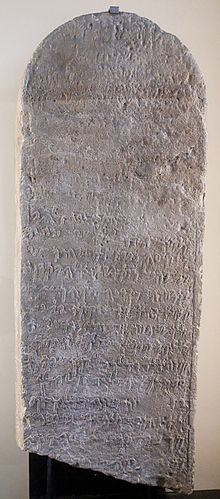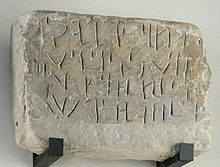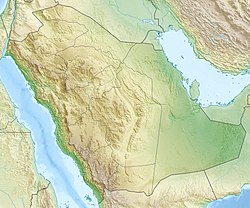Tayma
Tayma
تيماء | |
|---|---|
 Old Town of Tayma | |
| Coordinates: 27°37′47″N 38°32′38″E / 27.62972°N 38.54389°E | |
| Country | |
| Province | Tabuk province |
| Time zone | UTC+3 (AST) |
Tayma /ˈteɪmə/ (Taymanitic: 𐪉𐪃𐪒, TMʾ, vocalized as: Taymāʾ;[1] Arabic: تيماء, romanized: Taymāʾ) is a large oasis with a long history of settlement, located in northwestern Saudi Arabia at the point where the trade route between Medina and Dumah (Sakakah) begins to cross the Nafud desert. Tayma is located 264 km (164 mi) southeast of the city of Tabuk, and about 400 km (250 mi) north of Medina.[2][3] It is located in the western part of the Nafud desert.
History
[edit]The historical significance of Tayma is based on the existence there of an oasis, which helped it become a stopping point on commercial desert routes.[4] An important event was the presence there of Nabonidus, the last Neo-Babylonian emperor, who took residence there in the mid-6th century BC.[4]
Bronze Age: Egyptian inscription
[edit]Recent archaeological discoveries show that Tayma has been inhabited since at least the Bronze Age. In 2010, the Ministry of Tourism of Saudi Arabia announced the discovery of the Pharaonic Tayma inscription by Ramesses III about 60 kilometers northwest of Tayma. It read "'The King of Upper and Lower Egypt, Lord of the Two Lands, User-Maat-Ra, beloved of Amun' -- 'The Son of Ra, Lord of Crowns, Ramesses, ruler of Heliopolis' -- 'Beloved of the "Great Ruler of All Lands'".[5] This was the first confirmed find of a hieroglyphic inscription on Saudi soil. Based on this discovery, researchers have hypothesized that Tayma was part of an important land route between the Red Sea coast of the Arabian Peninsula and the Nile.[citation needed]
Assyrian, Babylonian, and biblical sources
[edit]
The oldest mention of the oasis city appears as "Tiamat" in Neo-Babylonian inscriptions dating as far back as the 8th century BC. The oasis developed into a prosperous city rich in wells and handsome buildings. Tiglath-pileser III received tribute from Tayma[6] and Sennacherib (r. 705–681 BC) named one of Nineveh's gates the Desert Gate, recording that "the gifts of the Sumu'anite and the Teymeite enter through it". It was rich and proud enough in the seventh century BC for Jeremiah to prophesy against it in Jeremiah 25:23: "Dedan, Tema, and Buz, and all those who have their hair clipped". It was ruled then by a local Arab dynasty known as the Qedarites. The names of two 8th century BC queens, Šamši and Zabibe, are recorded.[citation needed]
Emperor Nabonidus (ruled c. 556–539 BC) conquered Tayma, and for ten years of his reign retired there to worship and search for prophecies, entrusting the kingship of Babylon to his son, Belshazzar.[6] Taymanitic inscriptions also mention that the people of Tayma fought wars with Dadān (Lihyan).[7][clarification needed]
Cuneiform inscriptions possibly dating from the 6th century BC have been recovered from Tayma.[8] They are known as the Tayma stones.
Tayma is mentioned several times in the Hebrew Bible. The biblical eponym is Tema, one of the sons of Ishmael, after whom the Land of Tema is named.[citation needed]
Jewish community: classical period and 12th century
[edit]According to Arab tradition, Tayma was inhabited by a Jewish community during the late classical period, but whether they were exiled Judeans or the Arab descendants of converts is unclear. The Jewish diaspora at the time of the Temple's destruction, according to Josephus, was in Parthia, Babylonia, Arabia, as well as some Jews beyond the Euphrates and in Adiabene. In Josephus' own words, he had informed "the remotest Arabians" about the destruction.[9] So, too, in pre-Islamic poetry, Tayma is often referred to as a fortified city belonging to the Jews, as an anonymous Arab poet wrote, "Unto God will I make my complaint heard, but not unto man; because I am a sojourner in Taymā, Taymā of the Jews!"[10]
As late as the 6th century AD, Tayma was the home of a wealthy Jew, Samaw'al ibn 'Adiya.[11][12]
Tayma and neighboring Khaybar were visited by Benjamin of Tudela sometime around 1170. He claimed that the city was governed by a Jewish prince. Benjamin was a Jew from al-Andalus who travelled to Persia and Arabia in the 12th century.
Crusader threat
[edit]In the summer of 1181, Raynald of Châtillon, Prince of Antioch and Lord of Oultrejordain, attacked a Muslim caravan near Tayma during a raid of the Red Sea area despite a truce between Saladin and Baldwin IV of Jerusalem.[13]
Climate
[edit]In Tayma, there is a desert climate. Most rain falls in the winter. The Köppen-Geiger climate classification is BWh. The average annual temperature in Tayma is 21.8 °C (71.2 °F). About 65 mm (2.56 in) of precipitation falls annually.
| Climate data for Tayma | |||||||||||||
|---|---|---|---|---|---|---|---|---|---|---|---|---|---|
| Month | Jan | Feb | Mar | Apr | May | Jun | Jul | Aug | Sep | Oct | Nov | Dec | Year |
| Mean daily maximum °C (°F) | 17.7 (63.9) |
21.1 (70.0) |
24.2 (75.6) |
29.4 (84.9) |
32.8 (91.0) |
36.1 (97.0) |
36.9 (98.4) |
37.1 (98.8) |
35.8 (96.4) |
31.5 (88.7) |
24.2 (75.6) |
18.9 (66.0) |
28.8 (83.9) |
| Mean daily minimum °C (°F) | 4.5 (40.1) |
6.9 (44.4) |
9.8 (49.6) |
14.5 (58.1) |
18.9 (66.0) |
22.2 (72.0) |
23.3 (73.9) |
23.3 (73.9) |
20.9 (69.6) |
16.5 (61.7) |
10.7 (51.3) |
5.8 (42.4) |
14.8 (58.6) |
| Average precipitation mm (inches) | 9 (0.4) |
4 (0.2) |
10 (0.4) |
9 (0.4) |
3 (0.1) |
0 (0) |
0 (0) |
0 (0) |
0 (0) |
7 (0.3) |
16 (0.6) |
7 (0.3) |
65 (2.6) |
| Source: Climate data | |||||||||||||
Archaeology
[edit]
The site was first investigated and mapped by Charles M. Doughty in 1877.[14] The Tayma stele discovered by Charles Huber in 1883, now at the Louvre, lists the gods of Tayma in the 6th century BC: Ṣalm of Maḥram and Shingala-and-Ashira (or rather, Ashima).[15] This Ashira may be Athirat/Asherah.[citation needed]
Archeological investigation of the site, under the auspices of the German Archaeological Institute, is ongoing.[16][17]
Clay tablets and stone inscriptions using Taymanitic script and language were found in ruins and around the oasis. Nearby Tayma was a Sabaean trading station, where Sabaean language inscriptions were found.
Economy
[edit]Historically, Tayma is known for growing dates.[18] The oasis also produced rock salt, which was distributed throughout Arabia.[19] Tayma also mined alum, which was processed and used for the care of camels.[20]
Points of interest
[edit]- Qasr Al-Ablaq (قصر الأبلق) is a qasr located on the southwest side of the city. It was built by the Arab Jewish poet and warrior Samaw'al ibn 'Adiya and his grandfather 'Adiya in the 6th century.
- Qasr Al-Hamra (قصر الحمراء), a palace was built in the 7th century BC.
- Tayma has an archaeologically significant perimeter wall built around three sides of the old city in the 6th century BC.
- Qasr Al-Radhm (قصر الرضم)
- Haddaj Well (بئر هداج)
- Cemeteries
- Many Aramaic, Lihyanite, Thamudic, and Nabataean inscriptions
- Qasr Al-Bejaidi (قصر البجيدي)
- Al-Hadiqah Mound
- Al Naslaa rock formation
- Many museums. Although Tayma has museums of its own such as the "Tayma Museum of Archaeology and Ethnography", many artifacts from its history have been spread to other museums. Early finds such as the "Tayma Stele" are at the Louvre in Paris among others while large museums of national importance in Saudi Arabia, such as the National Museum of Saudi Arabia in Riyadh and the Jeddah Regional Museum of Archaeology and Ethnography also have significant collections of items from or related to ancient Tayma.
See also
[edit]References
[edit]- ^ Kootstra 2016.
- ^ "Tema - Hastings' Dictionary of the Bible -". Retrieved 2021-03-27 – via StudyLight.org.
- ^ "Tema in the International Standard Bible Encyclopedia". International Standard Bible Encyclopedia Online. Retrieved 2021-03-28.
- ^ a b "Tayma - Arabian Rock Art Heritage". Retrieved 2019-02-10.
- ^ Sperveslage, Gunnar, and Ricardo Eichmann, "Egyptian Cultural Impact on North-West Arabia in the Second and First Millennia BC", Proceedings of the Seminar for Arabian Studies, vol. 42, pp. 371–83, 2012
- ^ a b "Tayma - Arabian Rock Art Heritage". Retrieved 2023-07-17.
- ^ "krc2.orient.ox.ac.uk" (PDF). Archived from the original (PDF) on 2016-10-19. Retrieved 2019-08-14.
- ^ Folmer, M. L. (1995). The Aramaic Language in the Achaemenid Period: A Study in Linguistic Variation. Peeters Publishers. ISBN 978-90-6831-740-4.
- ^ Josephus. The Jewish War. Translated by Whiston, William. 1.1.5 – via PACE: Project on Ancient Cultural Engagement. Greek: Ἀράβων τε τοὺς πορρωτάτω = Preface to Josephus' De Bello Judaico, paragraph 2, "the remotest Arabians" (lit. "the Arabian [Jews] that are further on").
- ^ Yāqūt, Šihāb al-Dīn ibn ‘Abd Allah al-Ḥamawī (1995). "Taimā". Mu'jam al-Buldān. Vol. II. Beirut. p. 67;
{{cite book}}: CS1 maint: location missing publisher (link) cf. al-Ṭabbā‘ in his Forward to Samaw’al 1997, p. 7[full citation needed] - ^ Margoliouth, David Samuel (1906). "A poem attributed to Al-Samau'al". Journal of the Royal Asiatic Society. London: 363–371. JSTOR 25210253.
- ^ A‘šā (1968). Muḥammad Muḥammad Ḥusayn (ed.). Dīwān al-a'šā al-kabīr maymūn bn qays: šarḥ wa-ta'līq (in Arabic). Beirut. pp. 214, 253.
{{cite book}}: CS1 maint: location missing publisher (link) - ^ Leiser, Gary La Viere (1977). "The Crusader Raid in the Red Sea in 578/1182–83". Journal of the American Research Center in Egypt. 14: 87–100. doi:10.2307/40000370. JSTOR 40000370.
- ^ Dougherty, Raymond P. (1930). "A Babylonian City in Arabia". American Journal of Archaeology. 34 (3): 296–312. doi:10.2307/497985. JSTOR 497985. S2CID 191390322.
- ^ Miller, Robert D. II (2021). Yahweh: Origin of a Desert God. Vandenhoeck & Ruprecht. p. 124. ISBN 9783647540863.
- ^ Hausleiter, A. (2010). "L'oasis de Tayma". In al-Ghabban, A. I.; et al. (eds.). Routes d'Arabie. Archéologie et Histoire du Royaume Arabie-Saoudite (in French). Somogy. pp. 218–239. ISBN 978-2-7572-0393-4.
- ^ Hausleiter, A. (2010). "La céramique du début de l'âge dur Fer". In al-Ghabban, A. I.; et al. (eds.). Routes d'Arabie. Archéologie et Histoire du Royaume Arabie-Saoudite (in French). Somogy. p. 240. ISBN 978-2-7572-0393-4.
- ^ Prothero 1920, p. 83.
- ^ Prothero 1920, p. 97.
- ^ Prothero 1920, p. 98.
Sources
[edit]- Kootstra, Fokelien (2016). "The Language of the Taymanitic Inscriptions & its classification". Arabian Epigraphic Notes. 2: 67–140. Retrieved 14 December 2022.
- Prothero, G.W. (1920). Arabia. London: H.M. Stationery Office. p. 83.
External links
[edit]![]() Media related to Tayma at Wikimedia Commons
Media related to Tayma at Wikimedia Commons
- Deutsches Archäologisches Institut: Tayma
- Nabatea: The 12 Tribes of Ishmael: Tema
- about Jouf district
- Verse account of Nabonidus, translation at Livius.org
- Chronicle of Nabonidus Archived 2016-12-08 at the Wayback Machine, translation at Livius.org
- Travel through the province of Tabuk, Splendid Arabia: A travel site with photos and routes


